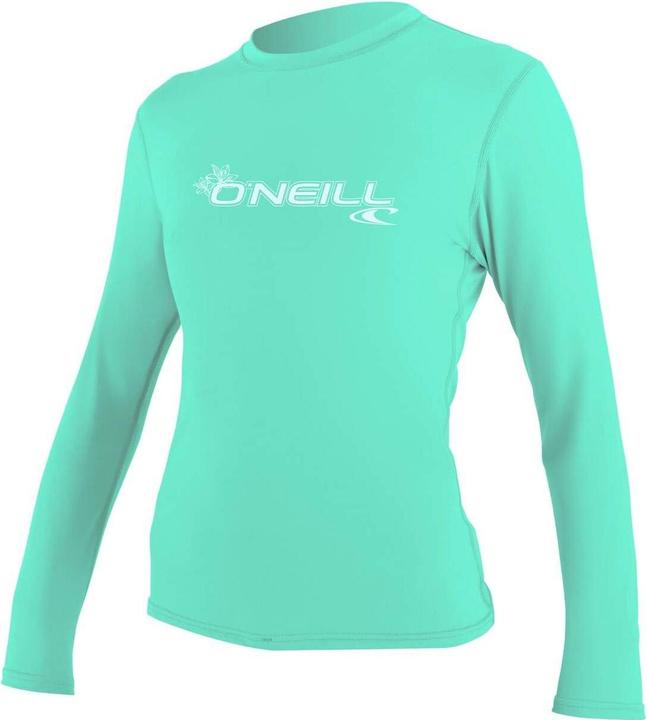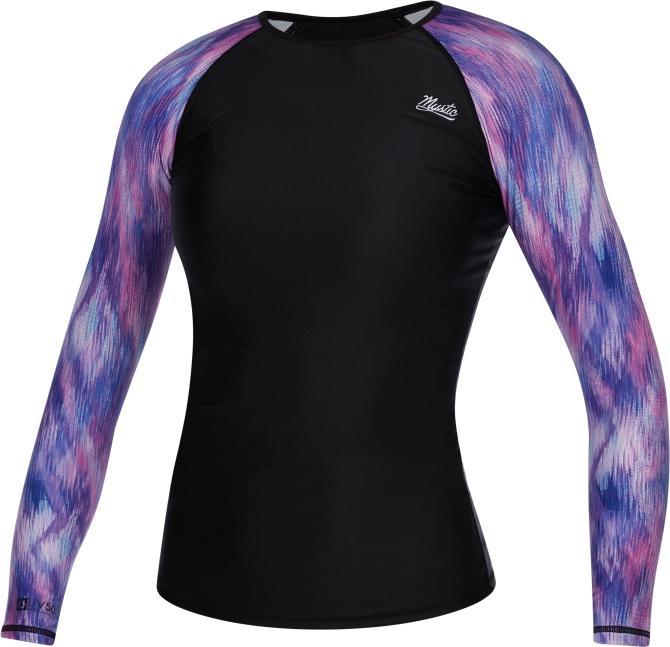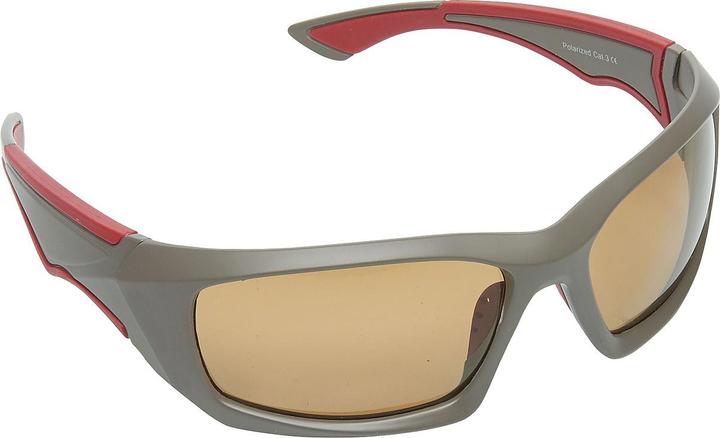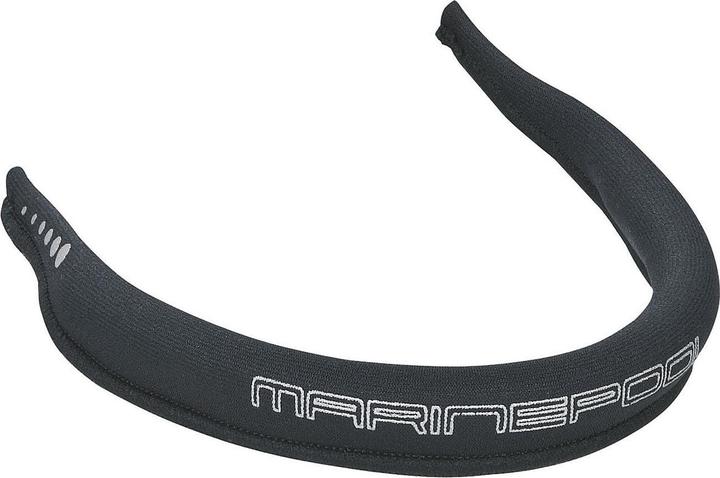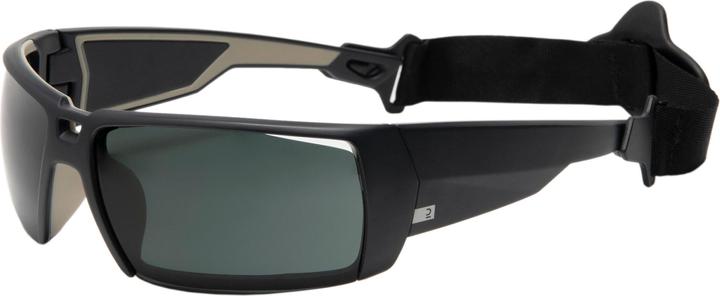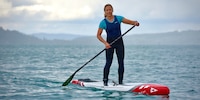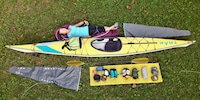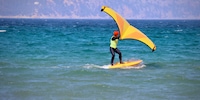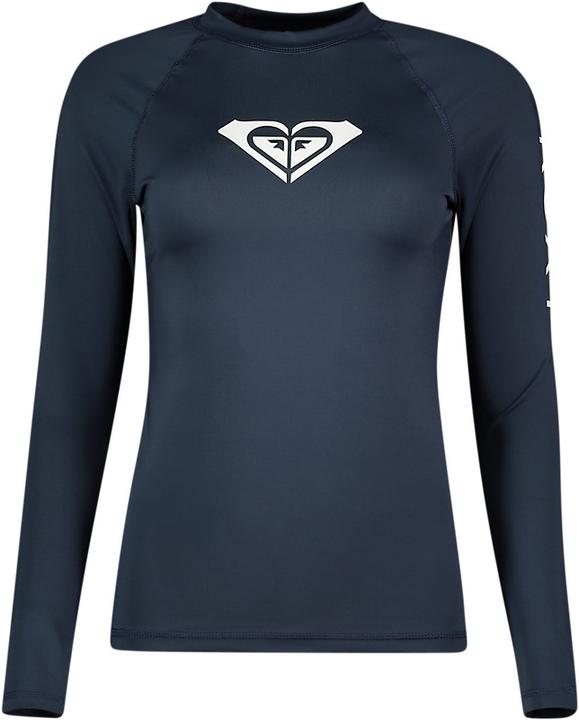

6 rules for staying safe on your SUP
Stand-up paddleboarding is fun and easy to learn. Here are a few tips and rules to help you get back to shore safely and not get in anyone’s way.
There are about 1,500 lakes in Switzerland and many of them are practically begging you to go stand-up paddleboarding (SUP) on them. But before you pack up your board and paddle and dive into the fun, there are a few things to keep in mind.
1. Landings and nature reserves – where to inform yourself
There are many lakes in Switzerland, but paddleboarding isn’t allowed on all of them. The paddel-spots.com website gives you an overview of the bodies of water and spots where you can paddleboard in Switzerland, Germany and Austria. The data is continuously being updated and new lakes added. Be sure to pay attention to conservation zones and restricted areas that are displayed in the app.
Here are some basic things to keep in mind: you need to keep at least 25 metres away from water plants like reeds and water lilies. (I know, I know, this is dry stuff. But as SUPers we’re subject to inland waterway regulations, and the laws that apply to kayakers and rowers also apply to us.)
Environmental protection associations recommend keeping a distance of 80 to 100 metres, as the reed belt is crucial to the young of many water birds, and we shouldn’t subject the animals to unnecessary stress. You should also stay away from gravel bars, which are often refuges for waterfowl.
You can find more information about nature conservation and water sports at the Verein Natur und Freizeit or at Swiss Canoe associations, for example. And don’t forget: areas marked with yellow buoys are off-limits for water sports enthusiasts. These are typically nature reserves or zones reserved for swimming. It’s best to give them a wide berth.
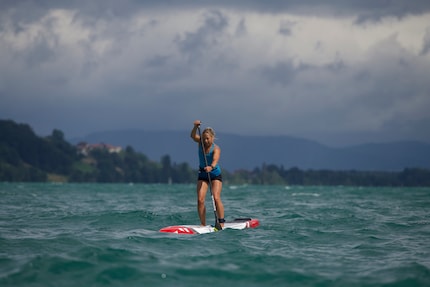
Source: Stefan Munsch
2. Wind, weather and waves – what you need to know
Many weather apps will show you quite reliably what to expect on the lake. The wind is especially important for stand-up paddleboarders. A fresh breeze with waves is a welcome challenge that can prove great fun for experienced SUPers. Others prefer calmer water. Be sure to check what to expect. Since wind strength isn’t always displayed in the same unit, here’s a handy conversion chart (link in German).
Winds from 3-5 Beaufort can prove quite demanding depending on your fitness level; we SUPers are like a sail, offering the wind a prime attack surface. So, be sure to also check the wind direction. With offshore winds on large lakes or the sea, you must be especially careful, or you’ll quickly find yourself further from shore than you’d like. If the wind is blowing more or less parallel to the shore, I recommend swimming upwind first, if possible, so you can come back with the wind pushing you back once you’re tired or if the wind picks up.
Lakes near mountains often have thermal winds that are not shown on weather apps. If you use them properly, you can do a nice lap with a tailwind. Of course, only if the wind shifts at the right time. If not, it can be extremely tiring to fight your way back against the wind. The best way to find out more is to ask the locals.
Finally, the water is no place for SUPers during thunderstorms. Should there be a storm warning (storm warning light flashing 90 times per minute), paddle back to shore as quickly as possible.
3. Life jackets for extra safety
Weather conditions can change rapidly, so a life jacket for added safety is welcome. If you’re paddling more than 300 metres from the shore, you must have a life jacket with you anyway, according to the laws on inland navigation (BSV). This is for your own safety as well as to avoid putting potential rescuers in danger. I find it more useful to actually put the vest on instead of just carrying it on the board. There are different types you can go for – I’ll explore those in a future article. Many of them are comfortable to wear even in summer. And if it gets too hot with a vest, you can always jump into the water to cool off.
Speaking of jumping into the water – of course, we SUPers never fall in. Nuh-uh. If we ever get wet, it’s obviously on purpose. To cool down. Duh. Either way, it makes sense to wear a leash. Since your board floats on the surface of the water, it can quickly be swept away by wind and waves. This has surprised many a good swimmer. With a leash, you’re sure to have your little lifeline island wherever on the lake you may be.
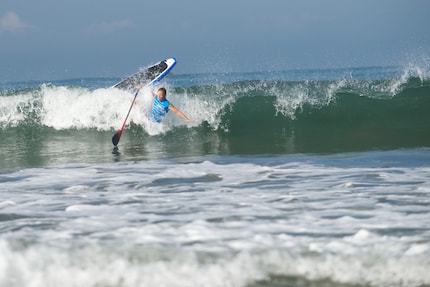
Source: Stefan Munsch
But: on rivers, a leash is extremely dangerous and therefore an absolute no-go. Should the leash catch on an obstacle, you’ve no chance of releasing it, what with the water pressure. The current will pull your foot towards the obstacle and pull your head underwater. I had the opportunity to try it first-hand during a river SUP course (with the support of professionals, of course), and it’s really no fun. If you insist on wearing a leash in the river, make it a special quick-release leash that’s attached to your torso and is easy to reach. If you want to paddle on a river, I recommend doing so with a trained guide.
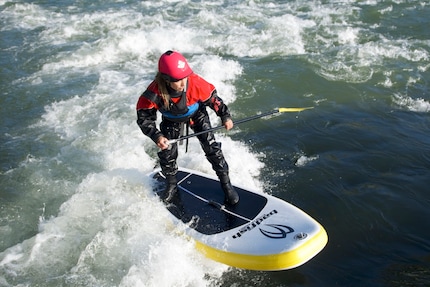
Source: Stefan Munsch
Another important safety measure is to write your name and contact information (preferably also your phone number) on your board or a waterproof tag attached to your board. That way, if your SUP is found on the lake, rescuers will have an easier time figuring out if you’re safe or if they need to launch a search and rescue operation.
4. Lycra and sun protection – how to dress appropriately
As early as on April’s first warm days, I’ll see SUPers getting on their boards in bikinis or swim trunks, covered in a thick layer of sunscreen. Not a good idea. Why? Because the temperature difference between the air and water is quite high. Falling Jumping into the water can lead to cold water shock. Dressing for the water temperature instead of the air temperature makes more sense. Either wear a wetsuit (which I’ll write about in detail in a future article) or with a special SUP dry suit. Variations of long- or short-sleeve neoprene shirts with normal sports shorts are also fine.
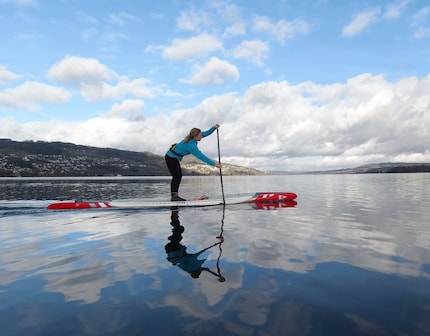
Source: Siri Schubert
When it gets warmer, I often wear Lycra shirts – typically with long sleeves and UV protection – to protect my skin from too much sun exposure. How quickly can you catch too much sun? My colleague Martin Jungfer tested just that. Besides, sweating on your board underneath all that sunscreen is anything but pleasant, if you ask me. I’m also not too pleased about the greasy film of sunscreen you can see flickering on the water at many SUP entry points. It’s harmful to animals and plants in and around the water.
Now, for sunglasses: I make sure to wear a model that floats, or I keep then wrapped around my head with a neoprene strap. I’m a fan of polarised glasses that reduce the reflections on the water, but that’s a matter of taste.
5. Right of way on the water – SUPers almost always last in line
The one has the right of way, the other’s lenient – such is the law on the water. Passenger ships and freight ships always have the right of way; they can't swerve quickly and can brake even less. Stand-up paddleboarding at boat docks is prohibited – you must keep enough distance. Sailboats also have the right of way. The same goes for professional fishermen, which you can recognise by circular yellow and white markings. If a fishing boat is dragging fishing rods marked with coloured buoys sideways or behind it, you must keep a distance of 50 metres. Otherwise, you risk damaging your equipment and that of the fisherman. Then no one will be having a good time. According to inland waterway regulations, motorboats don’t have the right of way – but I wouldn’t go for a trial of strength.
6. Keep it clean – clean your SUP before exploring a new lake
Invasive species, including the quagga mussel, are spreading in Swiss lakes. Clean your SUP with biodegradable SUP cleaner and water to avoid stowaways.
Congratulations! You’ve made it this far – and you might be thinking, «Oof, a lot of rules for a little paddling.» Rest assured, these tips and rules quickly become a habit. When you know where you’re allowed to paddle and what to look out for, time on the water becomes so much more relaxing.
Want to know more about SUP and water sports? Follow my profile for more tips and reviews.
Header image: Stefan Munsch
Research diver, outdoor guide and SUP instructor – I love being in, on and around water. Lakes, rivers and the ocean are my playgrounds. For a change of perspective, I look at the world from above while trail running or flying drones.
Practical solutions for everyday problems with technology, household hacks and much more.
Show all